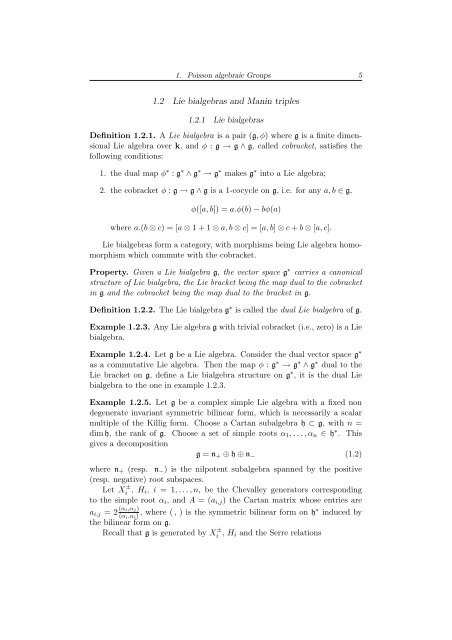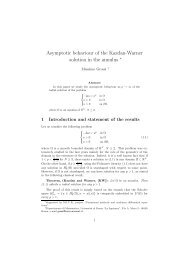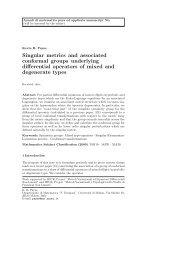Degree of Parabolic Quantum Groups - Dipartimento di Matematica ...
Degree of Parabolic Quantum Groups - Dipartimento di Matematica ...
Degree of Parabolic Quantum Groups - Dipartimento di Matematica ...
You also want an ePaper? Increase the reach of your titles
YUMPU automatically turns print PDFs into web optimized ePapers that Google loves.
1. Poisson algebraic <strong>Groups</strong> 5<br />
1.2 Lie bialgebras and Manin triples<br />
1.2.1 Lie bialgebras<br />
Definition 1.2.1. A Lie bialgebra is a pair (g, φ) where g is a finite <strong>di</strong>mensional<br />
Lie algebra over k, and φ : g → g ∧ g, called cobracket, satisfies the<br />
following con<strong>di</strong>tions:<br />
1. the dual map φ ∗ : g ∗ ∧ g ∗ → g ∗ makes g ∗ into a Lie algebra;<br />
2. the cobracket φ : g → g ∧ g is a 1-cocycle on g, i.e. for any a, b ∈ g,<br />
φ([a, b]) = a.φ(b) − bφ(a)<br />
where a.(b ⊗ c) = [a ⊗ 1 + 1 ⊗ a, b ⊗ c] = [a, b] ⊗ c + b ⊗ [a, c].<br />
Lie bialgebras form a category, with morphisms being Lie algebra homomorphism<br />
which commute with the cobracket.<br />
Property. Given a Lie bialgebra g, the vector space g ∗ carries a canonical<br />
structure <strong>of</strong> Lie bialgebra, the Lie bracket being the map dual to the cobracket<br />
in g and the cobracket being the map dual to the bracket in g.<br />
Definition 1.2.2. The Lie bialgebra g ∗ is called the dual Lie bialgebra <strong>of</strong> g.<br />
Example 1.2.3. Any Lie algebra g with trivial cobracket (i.e., zero) is a Lie<br />
bialgebra.<br />
Example 1.2.4. Let g be a Lie algebra. Consider the dual vector space g ∗<br />
as a commutative Lie algebra. Then the map φ : g ∗ → g ∗ ∧ g ∗ dual to the<br />
Lie bracket on g, define a Lie bialgebra structure on g ∗ , it is the dual Lie<br />
bialgebra to the one in example 1.2.3.<br />
Example 1.2.5. Let g be a complex simple Lie algebra with a fixed non<br />
degenerate invariant symmetric bilinear form, which is necessarily a scalar<br />
multiple <strong>of</strong> the Killig form. Choose a Cartan subalgebra h ⊂ g, with n =<br />
<strong>di</strong>mh, the rank <strong>of</strong> g. Choose a set <strong>of</strong> simple roots α1, . . .,αn ∈ h∗ . This<br />
gives a decomposition<br />
g = n+ ⊕ h ⊕ n−<br />
(1.2)<br />
where n+ (resp. n−) is the nilpotent subalgebra spanned by the positive<br />
(resp. negative) root subspaces.<br />
Let X ± i , Hi, i = 1, . . .,n, be the Chevalley generators correspon<strong>di</strong>ng<br />
to the simple root αi, and A = (ai,j) the Cartan matrix whose entries are<br />
ai,j = 2 (αi,αj)<br />
(αi,αi) , where (, ) is the symmetric bilinear form on h∗ induced by<br />
the bilinear form on g.<br />
Recall that g is generated by X ± i , Hi and the Serre relations








